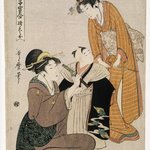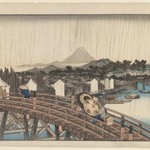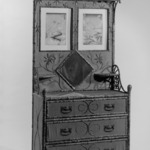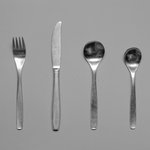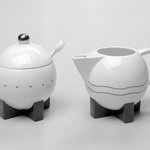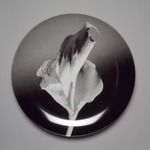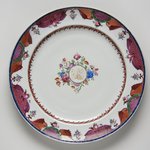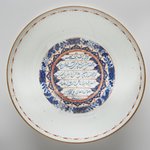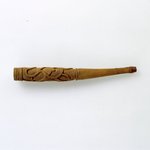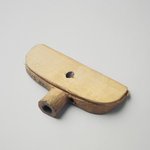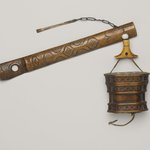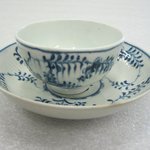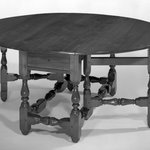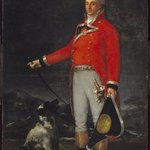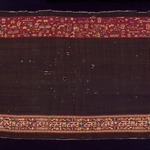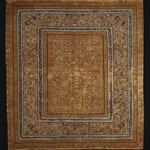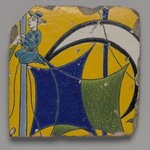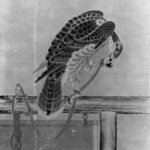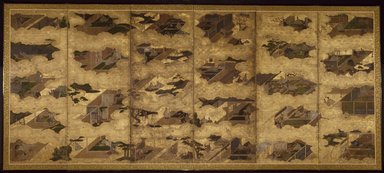
Scenes from the Tale of Genji
Asian Art
The port cities of colonial Spanish America were thriving centers of trade in international luxury goods. Japanese screens were recorded in New Spain by 1614, when Edo period examples decorated with golden clouds were introduced as diplomatic gifts. These biombos—whose name is derived from byobu, the Japanese word for folding screen—found immediate favor with the viceroyalty’s prosperous elite, inspiring Mexican variations throughout the colonial period (see nearby example).
Las ciudades portuarias de la Hispanoamérica colonial eran prósperos centros del comercio internacional de objetos de lujo. Los biombos japoneses aparecen registrados en la Nueva España desde 1614, cuando algunos ejemplares del periodo Edo decorados con nubes de oro se presentaron como regalos diplomáticos. Estos biombos—cuyo nombre proviene de byobu, la palabra japonesa para pantalla plegable—encontraron el inmediato favor de la próspera élite de los virreyes y sirvieron de inspiración para versiones mexicanas durante todo el periodo colonial (ver ejemplo cercano).
Las ciudades portuarias de la Hispanoamérica colonial eran prósperos centros del comercio internacional de objetos de lujo. Los biombos japoneses aparecen registrados en la Nueva España desde 1614, cuando algunos ejemplares del periodo Edo decorados con nubes de oro se presentaron como regalos diplomáticos. Estos biombos—cuyo nombre proviene de byobu, la palabra japonesa para pantalla plegable—encontraron el inmediato favor de la próspera élite de los virreyes y sirvieron de inspiración para versiones mexicanas durante todo el periodo colonial (ver ejemplo cercano).
MEDIUM
Six-panel screen, ink and color on paper
DATES
first half of 17th century
PERIOD
Edo Period
DIMENSIONS
Overall: 66 3/8 x 150 in. (168.6 x 381 cm)
each panel: 66 3/8 x 25 in. (168.6 x 63.5 cm)
image (outer panel): 60 x 22 in. (152.4 x 55.9 cm)
image (inner panel): 60 x 24 1/2 in. (152.4 x 62.2 cm) (show scale)



COLLECTIONS
Asian Art
ACCESSION NUMBER
81.283
CREDIT LINE
Gift of Dr. John Fleming
MUSEUM LOCATION
This item is not on view
CAPTION
Scenes from the Tale of Genji, first half of 17th century. Six-panel screen, ink and color on paper, Overall: 66 3/8 x 150 in. (168.6 x 381 cm). Brooklyn Museum, Gift of Dr. John Fleming, 81.283. Creative Commons-BY (Photo: Brooklyn Museum, 81.283_SL3.jpg)
IMAGE
overall, 81.283_SL3.jpg. Brooklyn Museum photograph
"CUR" at the beginning of an image file name means that the image was created by a curatorial staff member. These study images may be digital point-and-shoot photographs, when we don\'t yet have high-quality studio photography, or they may be scans of older negatives, slides, or photographic prints, providing historical documentation of the object.
RIGHTS STATEMENT
Creative Commons-BY
You may download and use Brooklyn Museum images of this three-dimensional work in accordance with a Creative Commons license. Fair use, as understood under the United States Copyright Act, may also apply.
Please include caption information from this page and credit the Brooklyn Museum. If you need a high resolution file, please fill out our online application form (charges apply).
For further information about copyright, we recommend resources at the United States Library of Congress, Cornell University, Copyright and Cultural Institutions: Guidelines for U.S. Libraries, Archives, and Museums, and Copyright Watch.
For more information about the Museum's rights project, including how rights types are assigned, please see our blog posts on copyright.
If you have any information regarding this work and rights to it, please contact copyright@brooklynmuseum.org.
RECORD COMPLETENESS
Not every record you will find here is complete. More information is available for some works than for others, and some entries have been updated more recently. Records are frequently reviewed and revised, and we welcome any additional information you might have.
